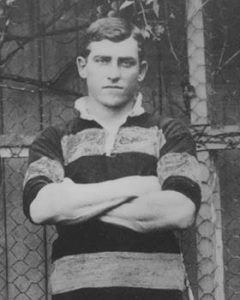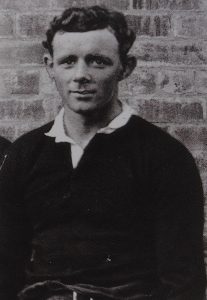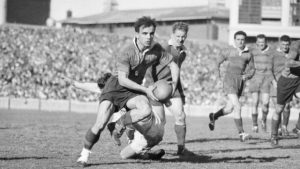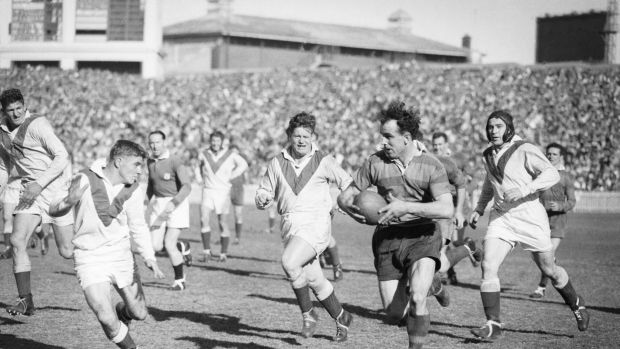The Best Fullbacks in Australian Rugby League History
There is arguably no position bursting with all-time greats like fullback, which is emphasised by the glittering array of stars that have missed out on this top 10 list.
Western Suburbs’ great pre-war captain Frank McMillan was tough to leave out, as were the dominant custodians of the 1980s, Garry Jack and Gary Belcher.
More recently, with fullback rivalling halfback as the most important position on the field, the likes of Anthony Minichiello, Matt Bowen and Tim Brasher were among the dominant players of their time.
Meanwhile, versatile types Brian Carlson, Greg Inglis, Jarryd Hayne and Darius Boyd haven’t had the opportunity to shine at representative level often enough to unset the following 10 legends.
10. Charles Fraser
Charles ‘Chook’ Fraser’s longevity and versatility mark him as a special player of Australian Rugby League’s formative decades – but it was in the No.1 jumper that he enjoyed his greatest triumphs at representative level. Fraser was chosen to tour with the 1911-12 ‘Australasian’ Kangaroos, and made his Test debut at fullback in the first encounter England aged 18 years and 301 days – retaining the record as Australia’s youngest Test player for 97 years. The brilliant playmaker played two Tests at five-eighth against the touring England side in 1914, before playing a vital role in the Balmain dynasty’s run of five premierships in six seasons from 1915-20, mostly as a centre. Fraser scored a memorable try from pivot in the first Test victory against England in 1920 and reverted to fullback as Australia secured its last Ashes series win for 30 years, while he captained his country in all three Tests on the 1921-22 Kangaroo Tour in the absence of injured skipper Les Cubitt. The Balmain legend captain-coached the club to the 1924 premiership and finished two years later with a club record of 185 games that stood for more than four decades. The diminutive and inventive ‘Chook’ Fraser was capable of playing anywhere in the backline, and was named at centre in Balmain’s Team of the Century in 2000 to accommodate Garry Jack.

Charles Fraser was one of rugby league’s most brilliant pre-war fullbacks
9. Les Johns
A shining example of Les Johns’ brilliance was his selection at fullback in the Team of the 1960s – a decade that featured fellow all-time great custodians Graeme Langlands, Keith Barnes and Ken Thornett. The golden-haired Newcastle champion arrived at Canterbury in 1963 and toured with the Kangaroos at the end of the year, but played the role of understudy to Test fullback Thornett. Johns played in Australia’s Ashes-deciding third Test victory in 1966 and toured with the 1967-68 Kangaroos after helping Canterbury to a grand final appearance, forcing Langlands to centre and playing all six Tests in Britain and France. Johns’ career was frequently hampered by injury, but he was a superb defender to complement a dazzling array of attacking attributes and was an outstanding goalkicker. His standing at Canterbury is emphasised by his selection at fullback in best-ever club combinations in 1985 and 2005.
8. Howard Hallett
Arguably the first truly great Australian fullback, Howard Hallett’s name ranks alongside luminaries such as Harold Horder, Alf Blair, Benny Wearing and George Treweek in South Sydney’s pre-WWII narrative. Hallett played 155 games for the Rabbitohs from 1909-24, encompassing three premiership triumphs. A 1911-12 Kangaroo tourist, Hallett played six Tests against England in an era where international football was sporadic, but he starred regularly for NSW at interstate level and on tours of New Zealand. His on-field trademarks were a powerful kick, watertight defence and the safest pair of hands in the game, earning him the nickname ‘The Rock of Gibraltar’. Hallett ranked at No.40 in Rugby League Week’s list of the top 100 players of all time in 1992, while he was also a member of the ARL’s 100 Greatest Players named in 2008.

Howard Hallett starred at fullback during his 15 seasons with the Rabbitohs
7. Keith Barnes
Invariably, discussion about Keith Barnes’ wonderful career turns to his outstanding goalkicking ability – he was a phenomenal match-winner with the boot – but he was also a courageous, skilful and unflappable fullback, and one of rugby league’s finest captains. The Welsh-born Barnes debuted for Australia during the 1957 World Cup, before captaining the 1959-60 Kangaroos to Britain and France, top-scoring for the squad with 202 points. Barnes led his country in 10 of his 17 Test appearances, a captaincy mark second only to Clive Churchill at the time. He captained Balmain in the 1964 and ’66 grand final losses to St. George, before retiring in 1968 with a then-premiership record 1,519 points to his name. Ironically, Balmain claimed its last premiership a year later, but Barnes was rightly recognised as the greatest Tiger of them all – the Men of League named him as Balmain’s greatest clubman as part of the 2008 Centenary celebrations.
6. Ken Thornett
Ken Thornett’s nickname – ‘The Mayor of Parramatta’ – gives a fair indication of the brilliant fullback’s impact on his club. A rugby union convert, Thornett arrived at Parramatta via English club Leeds in 1962. After six straight wooden spoons, the Eels qualified for their maiden finals series on the back of Thornett’s magnificent performances. He spearheaded the club’s top-four finishes in the following three seasons, including 1965 as captain-coach. Thornett, a dangerous attacking No.1 and impregnable in defence or under the high ball, had a brief but memorable spell in the international limelight. He played 12 Tests in the space of 13 months and toured with the 1963-64 Kangaroos alongside brother Dick, a former Wallaby and a teammate at Parramatta. Thornett starred in Australia’s resounding Ashes triumph over Great Britain – the first series win on British soil in 52 years. He left Parramatta for Coonabarabran at the end of 1968, but made a triumphant return in 1971 to revive the Eels’ flagging fortunes, captaining the club to a finals appearance.
5. Graham Eadie
Woy Woy product Graham Eadie debuted for Manly as a 17-year-old in 1971; by the time he was 20, Eadie had won two grand finals and made his Test debut on the 1973 Kangaroo Tour. A 95kg powerhouse, ‘Wombat’ built a reputation as one of the most damaging fullbacks rugby league has produced – and one of the best. Eadie played in four grand final victories for the Sea Eagles, with his magnificent performance in the 1978 grand final replay paving the way for a 16-0 triumph. He replaced injured captain-coach Graeme Langlands at fullback during the 1973 Ashes series and was Australia’s first-choice No.1 from 1975 until the end of the decade, playing 20 Tests. Eadie’s goalkicking prowess and powerful ball-running earned him a then-premiership record 1,917 points by the time he retired after Manly’s 1983 grand final loss (the record was eclipsed two years later by Mick Cronin). In a wonderful postscript to his career, Eadie was lured out of retirement by former Test teammate Chris Anderson to play for Halifax and won the Lance Todd Trophy as man of the match in the club’s 1987 Challenge Cup final victory.
4. Billy Slater
We will never know how much Billy Slater would have achieved had shoulder injuries not wrecked his 2015-16 seasons – and there could still be more glory ahead for the veteran before he hangs up the boots – but his accomplishments and out-and-out brilliance mark him among the very best players the game has produced. A rookie sensation for the Storm in 2003, Slater scored one of State of Origin’s greatest tries in just his second appearance for Queensland in 2004. The Innisfail product was unquestionably one of the NRL’s most exciting attacking talents, boasting explosive speed and wonderful tryscoring instincts, but he was also erratic and inconsistent. The 2008 season proved a turning point: he made his Test debut, cemented the Queensland No.1 jersey and had confirmed his status as the game’s undisputed best fullback by the end of the year. A one-match suspension cost him the Dally M Medal, but he was named the Golden Boot winner and the inaugural RLIF Player of the Year. Slater won the Clive Churchill Medal after Melbourne’s 2009 grand final victory – and within two years he was challenging ‘The Little Master’s’ mantle as Rugby League’s best-ever custodian. His freakish deeds in attack and defence, peerless positional play, burgeoning ball-playing skills and unflagging support play had rendered him the complete package. An unwavering match-winner at club and representative level throughout the Storm’s harrowing 2010 salary cap drama, Slater won a belated Dally M Medal in 2011 and claimed the Golden Boot-RLIF Player of the Year double for the second time as his performances reached an unprecedented level. The third-highest try-scorer in premiership history, his place in representative teams have come under threat from the likes of Greg Inglis and Darius Boyd, but few players have produced as many highlights at Origin and Test level.
3. Graeme Langlands
Graeme ‘Changa’ Langlands placed fifth in Rugby League Week’s Top 100 poll in 1992 and second in the Daily Telegraph’s Top 100 in 2000 – a glowing appraisal of one of the game’s most accomplished, decorated and admired players. Langlands arrived at St. George – a club that had just secured its seventh straight premiership – from Wollongong in 1963. He won four titles in his first four seasons in Sydney (firstly in the centres and then in his preferred fullback spot) and was the last playing remnant of the Dragons’ world record run, retiring early in 1976 after six seasons as captain with his name elevated alongside Gasnier and Raper in the pantheon of the club’s greats. Fiercely competitive, courageous and regularly brilliant, ‘Changa’ toured three times with the Kangaroos (1963-64, 1967-68 and 1973) – the third tour as captain-coach. A prolific accumulator of points, Langlands’ phenomenal on-field deeds overshadowed any story numbers could tell. The freakish tries and extraordinary play he produced were a forerunner to modern superstars such as Billy Slater. There were disappointments in his wonderful career – the notorious ‘White Boots’ 1975 grand final is the best-known – but the multitude of match-winning performances far outweigh those aberrations. The shining highlight of his 45-Test career was undoubtedly the 1974 Ashes decider at the SCG; the 32-year-old captain was chaired from the field with the crowd chanting his name after a wonderful display in the 22-18 triumph – a fitting tribute for the great ‘Changa.’ He was named as an Immortal in 1999, and while Clive Churchill occupied the fullback spot in the Team of the Century selections in 2008, Langlands was chosen as a reserve in the ARL, and centre in the NSW and NSW Country line-ups.
2. Darren Lockyer
Though he played the last nine seasons of his extraordinary career at five-eighth, Darren Lockyer’s fullback tenure for Brisbane, Queensland and Australia from 1997-2003 render him worthy of this lofty standing amongst the code’s greatest No.1s. The bare figures of Darren Lockyer’s career are destined to amaze rugby league followers for generations to come. Records for most appearances in first grade, State of Origin and Test football – and unprecedented marks for most appearances as captain, most tries and longest career-span for Australia – are a testament to the modern-day legend’s durability and longevity. But the numbers tell only part of the story of Lockyer’s unsurpassed consistency and match-winning brilliance. The Roma product’s place among Australia’s finest fullbacks of all time was assured in 2003 after he spearheaded the Kangaroos’ incredible 3-0 Ashes cleansweep of Great Britain in his first series as skipper and was awarded the Golden Boot. He was also a three-time grand final winner, a Churchill medallist and an Origin series-winning skipper in the No.1 jumper, but equally important to his legacy was his role as the first genuine ‘second five-eighth’ style of fullback, taking on the bulk of the playmaking duties – particularly for the Broncos and Maroons – while also proving himself as the consummate all-rounder with a dazzling ball-runner capable of coming up with incredible defensive plays. He shifted to five-eighth in 2004 – a selfless move for the benefit of his Brisbane club side – and became one of the best-ever pivots. Lockyer won a second Golden Boot in 2006 after captaining the Broncos, Queensland and Australia to stunning successes in one of the most extraordinary seasons by an individual in the code’s history. His gliding, incisive running and ball-playing class were features of his tenure at fullback – the position he was named in when Queensland’s Team of the Century was announced in 2008 – while he developed into one of the greatest ball-players and cool-headed match-winners of all time after his transition to the No.6. Lockyer can lay claim to being arguably the greatest clutch player rugby league has ever known. As his career wore on, Lockyer produced match-deciding plays in the dying minutes and seconds with incredible regularity. Lockyer possessed remarkable toughness, while he invariably responded to criticism with a man of the match performance.
1. Clive Churchill
Clive Churchill’s name is invariably the first put forward when the subject of rugby league’s greatest player comes up for debate. The Newcastle fullback went to South Sydney in 1947 and became the greatest Rabbitoh – the pivotal figure in the club’s golden age that garnered five premierships in six seasons (1950-51 and 1953-55). As Australian captain, Churchill led rugby league in this country into a new era. He was the undisputed star and linchpin of the green-and-golds’ series victory over the touring Lions in 1950, breaking Great Britain’s 30-year-old stranglehold on the Ashes. Churchill was captain in 27 of his 37 Test appearances, captain-coaching the 1952-53 Kangaroo Tour squad and leading Australia to another home Ashes series triumph in 1954. Small in stature, Churchill played like a goliath. He was courageous, intensely competitive and perfected every facet of attack and defence. Churchill redefined fullback play, emulating the pioneering running fullbacks Charles ‘Chook’ Fraser and Frank McMillan, and taking it to a new level – Churchill was the catalyst for modern fullbacks becoming among the most dangerous attacking players in the code. His performance against Manly during Souths’ unbeaten run in the ‘Miracle of ’55’ – remaining on the field after breaking his arm to set up the levelling try and kick the match-winning conversion from the touchline – was Churchill’s most famous day in myrtle and cardinal, and summed up his greatest qualities. Many of rugby league’s pioneering players and administrators – including Dally Messenger and ‘Jersey’ Flegg – declared Churchill the best player they ever saw. He was named at fullback in the ARL Team of the Century; came in at No.1 in Rugby League Week (1992) and Daily Telegraph (2000) top 100 lists voted on by panels of experts; and was one of the four original Immortals – glowing acknowledgements of the greatness of the man they called ‘The Little Master.’

Rugby League Immortal Clive Churchill remains the king of fullbacks











Hard to pick just 10 , prob hard to pick just 20. I personally don’t know if Lockyer should be on that list …
Billy slater is the best fullback I have seen play
You’re not serious? Locky is top 3 for sure! Let alone top 10…
Na I don’t think he is …. maybe just scrap into the top 10 … wouldn’t have him top 5
Bret Nicholson Mullins?
Not even a mention mate!…would smoke them all.
Charles Fraser? C’mon
Lol who?
Ha ha, number 10, ridiculous
Howard Hallett! Never heard of both these blokes….obviously great players to represent their country…but come on.
The bloke writing the article wouldn’t even have been fucken born when they played, different game in the 1920s
Mullins,Slater,Minicello top 3 in my lifetime.
Yep… and brad godden
Paul Hauff lol
Both have Aussie jerseys hanging in their cupboard but…fkd if I know how but they have lol
Ha ha, the hoff, like a car crash
Slater was best athlete in oz at his peak let alone best fullback !
Ethan Sherlock pretty accurate but Hayne should be some where In the bottom half. Two dally m medals, and the only reason nsw has won a origin series in 12 years
Minichello should be there as well
Really have no idea to be honest. Would need a serious breakdown of what the ranking is based on.
The only real info I can find on Barnes is how great a goalkicker he was…. does that mean Daryl Halligan makes the top winger list?
Played fullback ahead of Johns and Thornett for Australia.
Played 14 tests, 1/4 grand final wins but 3 were against dragons. Played in the biggest upset in GF history contributing to the win..
Captained Australia
But can he consistently execute a 3 on 2? 😂😂
So we only accept players in the last 15 years- idiots
Lol ease up pal. I was vouching Barnes.
But hard to go past Hayne and minichello with Golden Boot and Dally m medals as well as distinguished rep careers
I just wanted to point out it is easy to pick players with the amount of coverage now. But Hayene- give me a break…. wonder how much he would have sooked getting belted in the 50s-80s?
Good to see there are still some passionate Keith Barnes fans out there!
Youre right…. if it was a list of the toughest fullbacks, Hayne would not make the list.
However, Id say he would have picked apart the defensive lines better than any other fullback in that era.
Aubert Puige- Quite famously in a game against Wigan (which was played in a snowstorm), he actually caught the ball with one hand while holding a cigarette in the other hand.
Legend…. gets my vote.
Haha it gets better.
He was known to not tackle a player if he believed it would demonstrate the fault of his team-mates for not previously making the tackle.
Haynes attitude looks pretty good in comparison.
😂😂😂
Garry Jack- changed how to defuse bombs – far better than at least Eadie and Lockyer in the position????
Jimmy Jack greatest back..
Billy slater best ever!
Nailed it